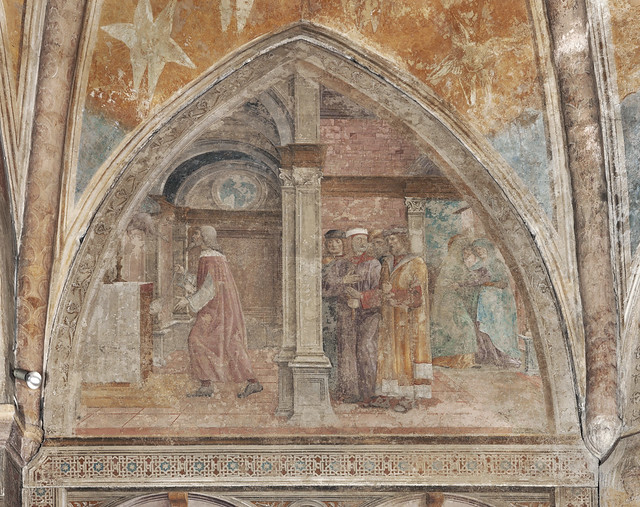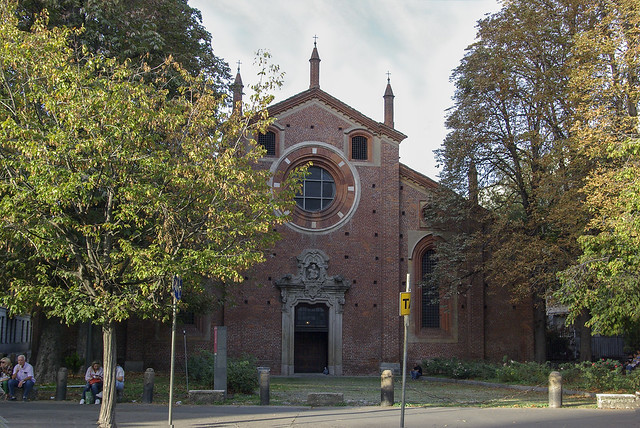Church of San Pietro in Gessate, Milan, ITALY
The Church of San Pietro in Gessate likely originated in the mid-13th century, when it was officiated by the Umiliati, a flourishing order that was widespread in Lombardy. The main self-supporting activity of this religious community involved textile production and wool processing. The domus of the Umiliati, situated outside Porta Tosa, was uniquely equipped with an internal navigable moat that connected to the Cerchia dei Navigli – a crucial waterway for transporting wool, which was a major commodity at that time.
Three distinctive elements define the identity of this building situated in the heart of Milan. Firstly, its architecture showcases unique and noteworthy features. Probably designed by the architect Guiniforte Solari, the architectural complex was completed in the 15th century on the initiative of the Benedictine Congregation of St. Justina, which made the future abbey one of the major reformed centres belonging to the order. Further renovations took place between the 16th and 17th centuries and at the beginning of the 20th century with the historic restoration of the façade (1912). Secondly, the fresco cycles decorating the side chapels, dating back to the 15th century, among the most important works by Lombard painters and other renowned European artists, enrich the site with an important historical and artistic value. Finally, having been bombed in August 1943, the building acquired historical relevance related to the events of World War II.
In the 1950s, following the reconstruction of the right wing – which was almost completely destroyed – and the necessary consolidation of the 15th-century chapels in the left nave, some of the wall paintings were torn out and repositioned. A further restoration of the fresco cycles took place in the 1990s, involving the Chapel of St. Anthony and the Chapel of St. Ambrose/Grifi, which is currently in a seriously deteriorated state. The chapel of St. Maurus, the only survivor of the right nave, also requires immediate intervention.
Although the roofs of the building were repaired about 20 years ago, the condition of the Church of San Pietro is causing a progressive deterioration of the decorations with the consequent loss of portions of the paintings. In 2018, a dehumidification system was installed, paving the way for the much-needed restoration of the interior surfaces, while overhauls of the roofs and exterior façades to protect the pictorial surfaces are still urgently needed. In spite of all previous efforts, the site is rapidly deteriorating and lacks the resources for the demanding works needed for its safeguard. It should also be considered that climate change and the increasing extreme weather events pose an additional risk factor for indoor and outdoor conservation. An urgent and complex restoration project is now needed to ensure the adequate protection of this church and its works of art.
The inclusion of the Church of San Pietro in the 7 Most Endangered Programme presents a vital opportunity to support the ongoing synergies involved in the conservation of this ancient site, and to offer a further glimpse into the future of Milan’s historic centre.
The nomination to the 7 Most Endangered Programme 2024 was made by an individual member of Europa Nostra from Italy (who is also a member of the project L’Arte inVita) with the support of the Pastoral Community “Holy Prophets” and the Superintendency of Archaeology, Fine Arts and Landscape for the city of Milan.
The L’Arte inVita project aims to highlight the value of the Church of San Pietro through a communication strategy involving the spreading of content and images online and onsite. Activities include awareness-raising campaigns aimed at disseminating the historical and artistic significance of the church and promoting its participatory preservation.
The commitment to preserving the integrity of the Church of San Pietro also involves the surrounding green area and the large churchyard, which helps to provide excellent visibility for the various initiatives, thus facilitating community involvement. The L’Arte inVita project not only aims to ensure the preservation of the site, but also imagines it as a model of urban regeneration, characterised by the integration of art, spirituality, history and nature in an increasingly desirable vision of ecological transition and dissemination of collective practices, animated by awareness and responsibility towards the common heritage.
The Advisory Panel of the 7 Most Endangered highlighted “the fruitful collaboration among civil society, the Church, and local institutions in supporting this irreplaceable cultural treasure”, and emphasised “the need to preserve and properly valorise the Church of San Pietro in Gessate, its frescoes and the tree-lined space in front of it”.
Report
Technical Report by the European Investment Bank Institute and Europa Nostra, February [PDF]




